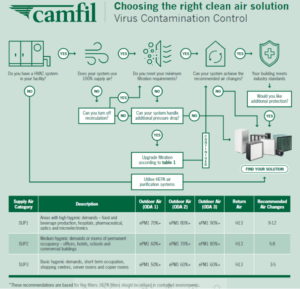Workplace air quality – A risk mitigating strategy for spread of airborne viruses

DAVID CRUISE
Marketing Manager
Camfil
On the 6th of July 2020, 239 leading scientists from over 32 different countries signed a research document to say that Covid-19 was an airborne virus. So what did this mean? Well, focussing on hand hygiene, social distancing and mask wearing were no longer the only risk mitigation strategies. Now improving the air quality within your building became one of the primary strategies for protecting the people in your building.
How do viruses move in the air?
As we all know viruses can be released into the air through coughing, sneezing, breathing and even talking. When viruses are released into the air it is in the form of droplets and aerosols. With the droplets, these are often too heavy and will drop onto the ground and surrounding surfaces (This is why hand cleaning and workplace sanitisation practices are important). When it comes to aerosols, these are often so small that they are undetectable by the human eye, these can remain airborne. These aerosols can not remain airborne by themselves, what they need is Particulate Matter (PM) to use as a vehicle. When the aerosol attaches to a particle it can remain airborne between 5 and 16 hours in poorly ventilated areas. To clean surfaces we use workplace sanitisation practices but what can we do to ensure the air is properly cleaned?
Ventilation and filtration
For the air we breathe there is two key problems we need to consider
- The Virus can remain in the air for 5-16 hours in poorly ventilated areas.
- The Virus can travel in the air using Particulate Matter (PM) as a vehicle
So how can these problems be addressed? Well, the first problem is quite simply solved. Improve ventilation. But what does this mean. In ventilation the key term to consider is air change rates. Simply put – how often the air volume in the room is replenished with clean, fresh air. Depending on the type of environment you work in there are guidelines for how many air changes should be achieved. The chart at the bottom of this blog post will help identify how many air changes are needed for your facility during current times
The second problem is based around the number of particulates in the air. The less particulates there is in the air the less chance there is for the virus to travel and remain airborne. This is where your clean air strategy comes into place. In most commercial and Industrial buildings their clean air requirement is serviced through HVAC systems. These systems control the airflow that enters the space (you can understand your air changes through this) as well as the quality of air that enters your building. The filter elements within the HVAC system will help remove the particulates from the air and ensure a cleaner work environment.
HVAC vs Air Purification risk mitigating strategies
For your HVAC strategy there are a number of key topics to consider. The flow graph at the bottom of this post outlines the key questions you need to ask yourself when deciding if you have sufficient clean air and air changes within your building. The basic fundamental of the flowgraph is to see if you are introducing enough clean fresh air to your buildings to protect your staff.
To increase this protection HEPA air purification systems are recommended for your facility. I guess you are asking yourself – Why are these the highest recommended protection barrier. These contaminants are built up internally by people coming into your building with the virus (It is why REHVA recommends turning off air recirculation in your building). With certified HEPA air purifiers they are working towards solving the two key problems identified earlier. They are increasing air changes and they are reducing particulate levels. A certified HEPA air purifier can remove 99.95% (H13) or 99.995% (H14) of the particles in the air and the purified air can help create additional air changes in your facility.
Key Considerations for choosing a clean air technology
- Technology Standards: Often clean air solutions will claim 99% effective. Ensure that there is a recognized industry standard for this claim. Ensure that this standard involves the removal of the contaminant from the air stream and not static surfaces. The HEPA filter in your air purifier should be Individually tested and certified to EN1822:2019 while your HVAC filters should be ISO 16890 certified.
- Filtration Efficiency: Your filtration or particulate capture efficiency should be measurable per system. This means that your filtration system should be individually tested and certified for guaranteed performance.
- Clean Air Delivery Rate: This is a key component for evaluating your air purification systems. How much clean air is going to be delivered into your area. The right clean air delivery rate will ensure your air purification system is sized right.
- Monitoring: The availability of smart connectivity to air quality sensors is beneficial. Smart sensors can ensure air quality targets are being achieved as well as control energy consumption through reducing operational efficiency when air quality targets are met.
- Gases: Your air purification system should not create air quality contamination risks such as ozone or other VOCs.

About the Author:
David Cruise is the Marketing Manager for Camfil throughout Continental Europe, Britain, Ireland and Middle East. Working for the last 9 years in the clean air industry has helped him gain a huge understanding of the importance of clean air and how it can protect our health.
Camfil are a world leader in the design, manufacture and supply of clean air technology around the world. With 26 manufacturing plants and 6 R&D centres throughout the world they are dedicated to creating clean air solutions that can help protect the health of people.

Discover our Safety Training Platform
Train your employees anytime, anywhere with our environmental, health, safety and wellness training platform.

TAILORED TRAINING
Discover our safety training courses and ehs onboardings, which can be customised and offered in several languages.

SAFETY MANAGEMENT
Ensure the distribution of your safety policy by training your permanent, temporary or seasonal staff.

GLOBAL MONITORING
Simplify the management of your safety policy thanks to the numerous dashboards and training reports.
